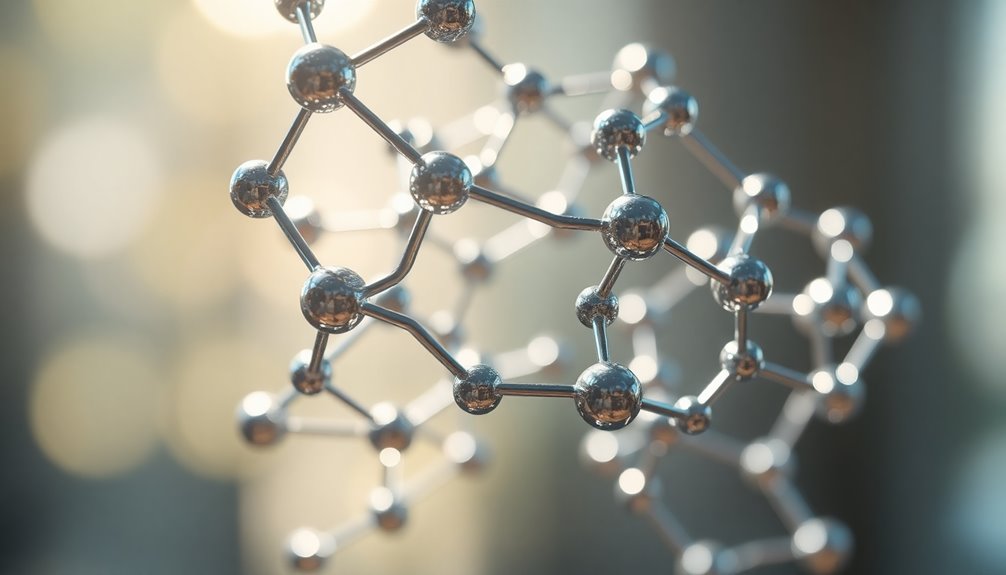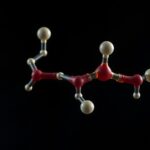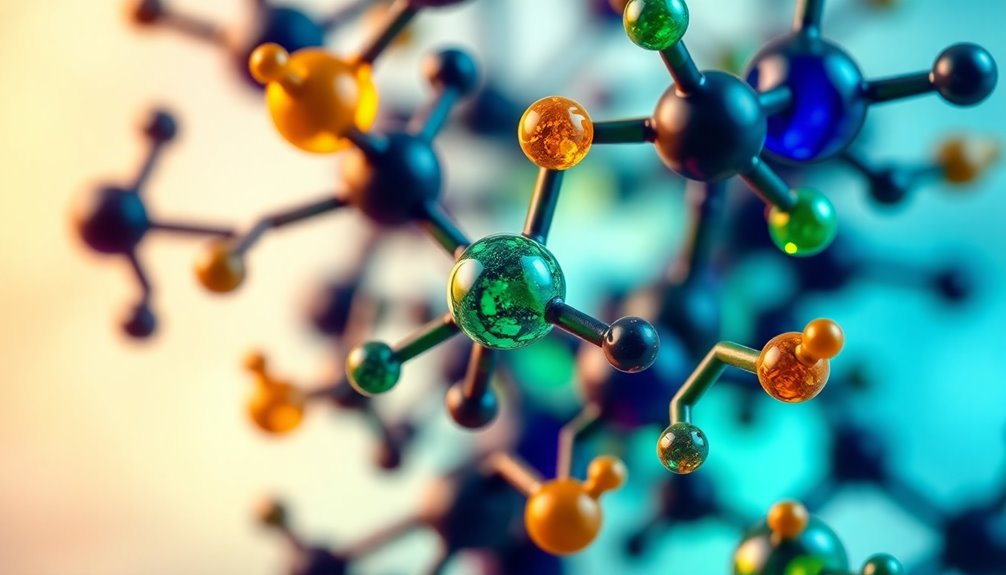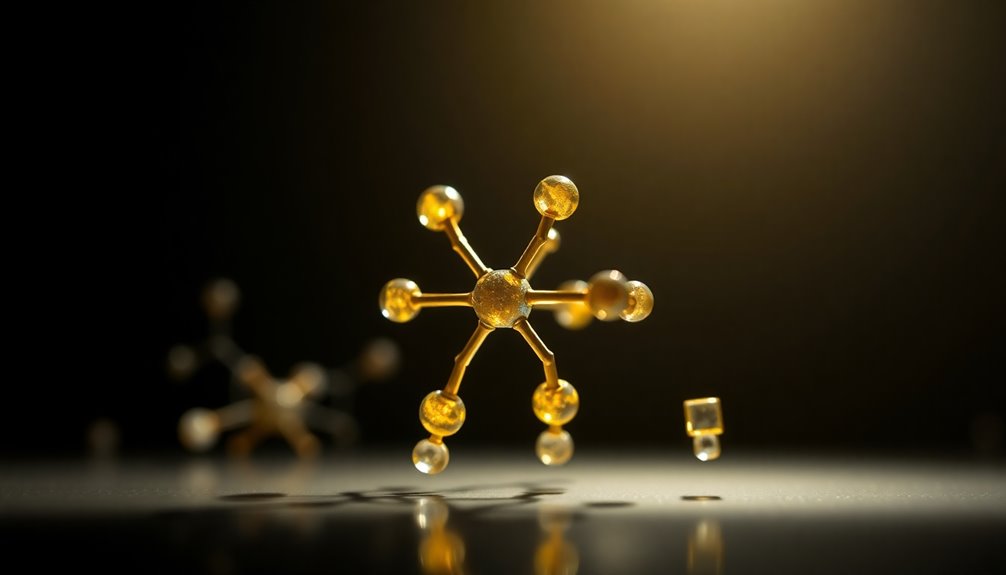Benzene is aromatic because of its unique cyclic structure with six carbon atoms. It has six delocalized π electrons, fitting perfectly into Hückel's Rule, which states that a compound needs 4n + 2 π electrons to be aromatic. This structure is planar, allowing effective overlap of p-orbitals, which enhances its stability through resonance. The equal bond lengths result from this resonance, making benzene less reactive compared to non-aromatic hydrocarbons. If you're curious about how these properties impact its reactivity and how benzene derivatives are used, keep exploring the fascinating world of aromatic compounds.
Key Takeaways
- Benzene has a cyclic, planar structure, allowing for continuous overlap of p-orbitals and delocalization of π electrons.
- It contains six π electrons, fitting Hückel's Rule (4n + 2) for aromaticity, with n=1.
- The delocalized π electron system contributes to benzene's increased stability through resonance energy.
- Electrophilic substitution reactions retain the aromatic nature of benzene, while addition reactions would disrupt it.
- Substituents on benzene influence its reactivity and stability, further defining its aromatic character.
Understanding Aromatic Hydrocarbons
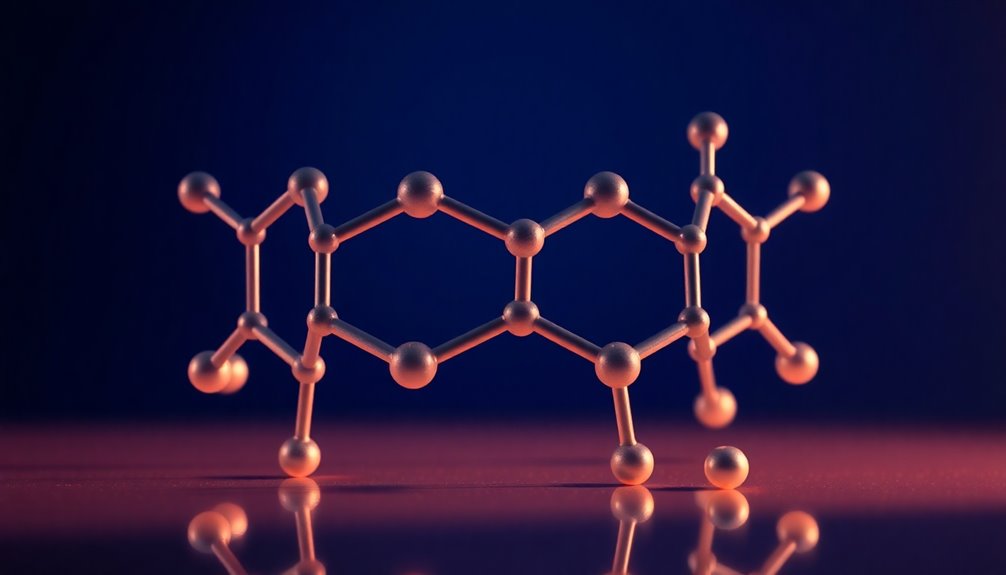
When you explore aromatic hydrocarbons, you'll quickly discover that benzene is a prime example of this fascinating class of compounds. This six-carbon cyclic structure boasts six delocalized π electrons, aligning perfectly with Hückel's Rule (4n + 2), where n equals 1.
The planar geometry of benzene enables effective overlap of p-orbitals, promoting electron delocalization, which enhances its stability and aromaticity. The resonance structures of benzene show an equal distribution of electron density among carbon atoms, resulting in consistent bond lengths—shorter than single bonds but longer than double bonds.
Because of this unique electron arrangement, aromatic compounds like benzene are less reactive than non-aromatic alkenes, preferring electrophilic substitution reactions, making benzene essential in organic chemistry and various industrial applications.
Significance of Hückel's Rule

You'll find that Hückel's Rule is essential for identifying whether a compound is aromatic.
It helps you determine the π electron count, which directly impacts a molecule's stability and reactivity.
Criteria for Aromaticity
A molecule's classification as aromatic hinges on specific structural criteria, most importantly Hückel's rule. For a compound to be aromatic, it must be cyclic and planar, allowing for a continuous loop of conjugated π electrons.
Hückel's rule states that the molecule should have 4n + 2 π electrons, where n is a non-negative integer. In the case of benzene, it has 6 π electrons, fitting this formula perfectly.
This arrangement enables effective delocalization of the π electrons, enhancing the molecule's stability. The resonance structures of benzene show that these electrons are evenly distributed among the carbon atoms, reinforcing its aromatic nature.
Adherence to Hückel's rule and these structural characteristics are essential criteria for determining aromaticity.
Π Electron Count
Understanding the π electron count is essential for grasping why benzene is classified as aromatic. Benzene contains 6 π electrons, which satisfies Hückel's rule—specifically, the formula 4n + 2, where n equals 1.
Hückel's rule indicates that a compound must be cyclic, planar, and have a conjugated system of π electrons to be aromatic. This unique arrangement allows the π electrons in benzene to be delocalized, enhancing its stability compared to non-aromatic compounds.
The resonance structures of benzene further illustrate the equal distribution of these π electrons, reinforcing its aromatic nature. Consequently, aromatic compounds like benzene exhibit distinctive chemical properties and behaviors due to their adherence to Hückel's rule, influencing their reactivity and overall stability.
Stability Implications
Benzene's classification as aromatic not only hinges on its π electron count but also has significant implications for its stability. According to Hückel's rule, benzene's six π electrons, with n equal to 1, provide a unique electronic structure that enhances its stability.
The cyclic and planar arrangement allows effective overlap of p orbitals, leading to the delocalization of these π electrons throughout the ring. This delocalization results in resonance stabilization, yielding equal bond lengths that are shorter than typical single bonds yet longer than double bonds.
Consequently, benzene is less reactive than alkenes and prefers substitution reactions. This remarkable stability showcases how aromaticity fundamentally influences benzene's chemical behavior and interactions with other compounds.
Structural Features of Benzene

When you look at benzene, its planar geometry plays an essential role in its stability and reactivity.
The sp² hybridization of carbon atoms allows for an effective conjugated π electron system, enabling the delocalization of electrons throughout the ring.
This unique structure is what makes benzene a classic example of aromatic compounds.
Planar Geometry Importance
The planar geometry of benzene plays an essential role in its chemical properties, allowing for effective overlap of p orbitals.
This structure, characterized by sp² hybridization, creates a flat, hexagonal arrangement that promotes the delocalization of π electrons throughout the ring. Because of this planarity, all carbon-carbon bond angles are approximately 120°, which is ideal for maintaining the stability of the conjugated π electron system.
The cyclic, planar form guarantees equal bond lengths, reflecting the resonance that contributes to benzene's aromatic nature. As a result, benzene satisfies Hückel's rule with its six π electrons, reinforcing its aromatic character and stability.
This unique geometry is fundamental to understanding why benzene behaves the way it does in chemical reactions.
Conjugated π Electron System
Understanding the conjugated π electron system in benzene is essential, as it underpins many of the compound's unique properties.
Benzene's structure consists of six carbon atoms, allowing for effective overlap of p orbitals. Each carbon atom is sp² hybridized, creating a planar geometry that promotes electron delocalization.
With six π electrons, benzene satisfies Hückel's rule (4n + 2) when n equals 1, confirming its aromatic character. This delocalization contributes greatly to benzene's stability, making it less reactive than non-aromatic compounds.
The resonance structures of benzene further illustrate that the electrons aren't localized; instead, they spread evenly across the entire ring. This shared electron distribution is key to understanding benzene's aromatic nature and chemical behavior.
Hybridization of Carbon Atoms
Benzene's aromatic properties stem from the hybridization of its carbon atoms. Each carbon atom in benzene is sp² hybridized, which means it forms three sigma bonds with two neighboring carbon atoms and one hydrogen atom.
This arrangement creates a planar structure with bond angles of approximately 120 degrees, characteristic of sp² hybridization. The sp² hybridization also allows each carbon to have a p orbital, enabling the delocalization of π electrons across the hexagonal ring.
This delocalization is essential, as it enhances benzene's stability; the π electrons aren't confined to individual bonds but are shared throughout the entire structure. This shared electronic system contributes considerably to benzene's aromatic character and overall stability.
Π Electron Delocalization
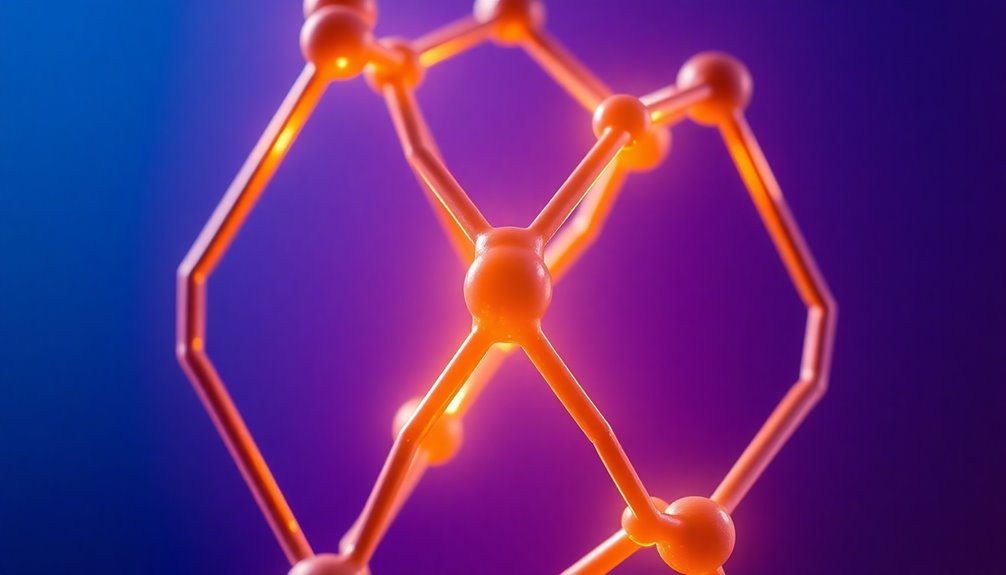
While exploring the structure of benzene, you'll notice its unique feature of π electron delocalization, which greatly contributes to its stability. The six π electrons are spread evenly across the carbon atoms, leading to resonance stabilization.
This delocalization results in several key characteristics:
- Equal Bond Lengths: The carbon-carbon bonds are all the same length, sitting between single and double bonds.
- Planar Geometry: The effective overlap of p orbitals permits smooth electron flow around the ring.
- Aromatic Stability: Following Hückel's rule, benzene's 6 π electrons confirm its aromatic nature, making it less reactive than typical alkenes.
These factors illustrate how delocalization enhances benzene's aromatic stability and influences its chemical behavior.
Stability of Aromatic Compounds
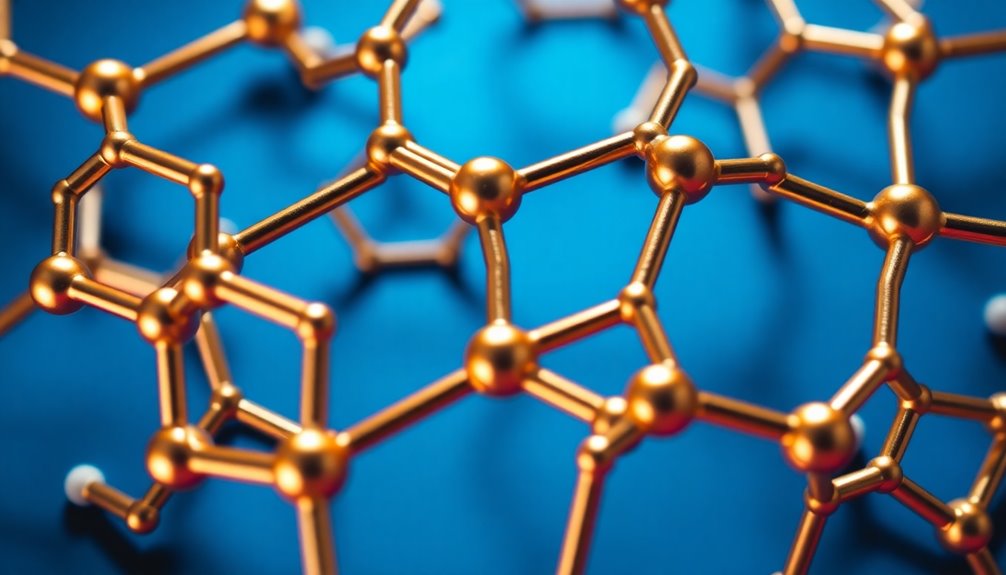
Aromatic compounds, like benzene, possess remarkable stability due to their unique structural features. The planar, cyclic structure allows for the delocalization of six π electrons, which adhere to Hückel's rule.
This delocalization leads to significant resonance stability, making aromatic compounds less reactive than their non-aromatic counterparts. You'll notice that the equal bond lengths in benzene indicate that the π electrons aren't localized in double bonds but are evenly distributed throughout the ring.
This resonance energy contributes to the lower energy and higher stability of aromatic compounds. Additionally, they typically undergo electrophilic substitution reactions, preserving their aromatic system, further enhancing their stability compared to reactions that would disrupt this unique structure.
Reactivity Patterns in Benzene

Understanding the stability of aromatic compounds naturally leads to an exploration of their reactivity patterns, particularly in benzene. As an aromatic hydrocarbon, benzene undergoes electrophilic substitution reactions instead of addition reactions, which helps preserve its aromatic stability.
Here are three key reactivity patterns you should consider:
- Electrophilic Substitution: Benzene's delocalized π electrons make it less reactive than non-aromatic hydrocarbons, promoting substitution.
- Effect of Substituents: The type of substituents on the benzene ring can either activate or deactivate the ring towards further electrophilic substitution.
- Stability: The resonance structures contribute to consistent bond lengths, further reducing overall reactivity compared to other compounds.
These factors highlight how benzene's unique structure influences its behavior in chemical reactions.
Derivatives of Benzene
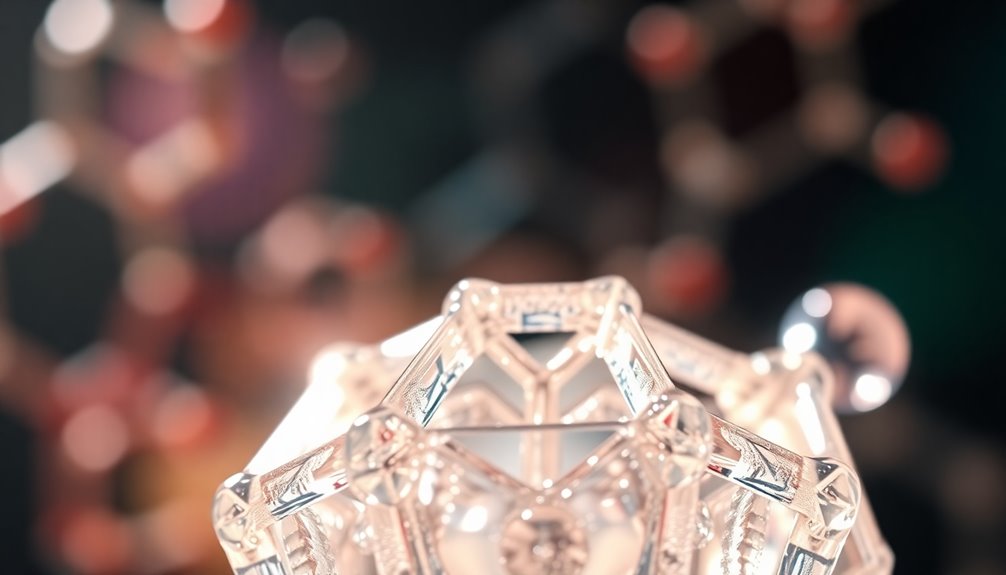
Benzene derivatives play an essential role in organic chemistry, as they form when one or more hydrogen atoms in the benzene ring are replaced by various functional groups. These derivatives exhibit unique properties influenced by their substituents, which affect their stability and reactivity compared to benzene itself. Common examples include:
| Derivative | Functional Group |
|---|---|
| Toluene | Methyl group |
| Phenol | Hydroxyl group |
| Aniline | Amino group |
The naming of these derivatives follows IUPAC conventions, where the substituent is indicated before "benzene." Benzene and its derivatives are vital in industries, serving as starting materials for dyes, plastics, and pharmaceuticals, highlighting their importance in both chemical synthesis and practical applications.
Historical Perspective on Aromaticity
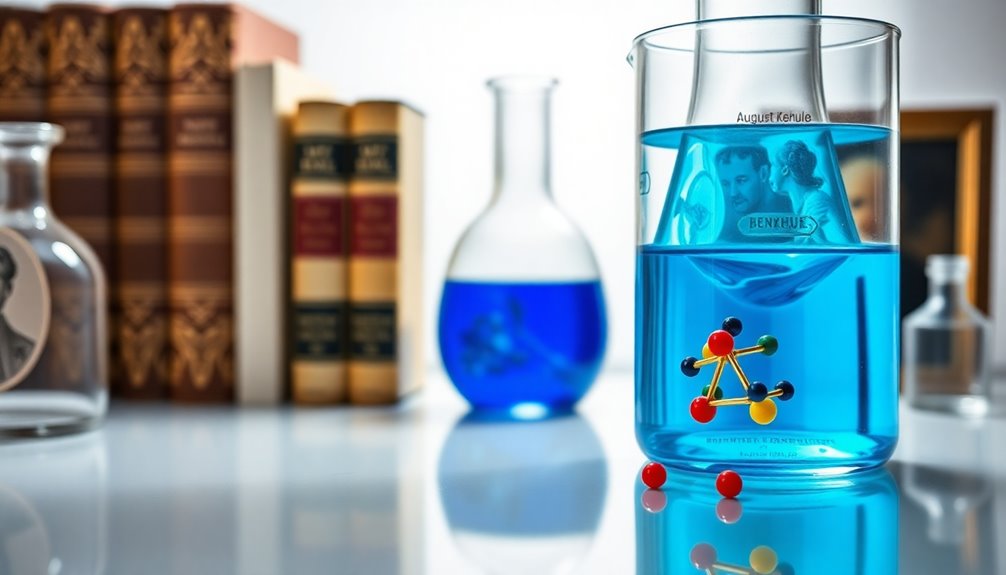
While the modern interpretation of aromaticity hinges on electronic structure, its historical roots trace back to the pleasant scents associated with certain compounds. Originally, "aromatic" referred to these appealing odors, but the understanding of what defines these compounds evolved considerably.
Key developments include:
- Early studies in the 19th century linked aromatic compounds to their distinct scents.
- Erich Hückel's work in the 1930s shifted focus to electronic properties, establishing criteria for aromaticity based on π electrons.
- Hückel's rule (4n + 2 π electrons) clarified the importance of the conjugated electron system.
Despite this progress, misconceptions about the term "aromatic" linger, often confusing scent with the electronic characteristics that truly define aromatic compounds today.
Applications of Aromatic Compounds

Aromatic compounds play an essential role across various industries, showcasing their importance beyond just their historical associations with pleasant scents.
In the pharmaceutical sector, you'll find aromatic hydrocarbons like benzene being used to synthesize a range of medications, thanks to their unique stability and reactivity.
Meanwhile, the dye industry relies on these compounds to create vibrant colors for textiles and inks. Aromatic hydrocarbons such as toluene and xylene serve as key solvents in industrial processes, facilitating chemical reactions.
In plastics, styrene, an aromatic monomer, is vital for producing polystyrene—a material widely used in packaging and insulation.
Additionally, aromatic compounds contribute to fragrances and flavoring agents, enhancing products in food and cosmetics industries. Their diverse applications highlight their significance in modern life.
Frequently Asked Questions
Why Is Benzene Called Aromatic?
Benzene's called aromatic because of its unique structure and stability.
You notice that it has a cyclic arrangement with alternating double bonds, which allows for the delocalization of electrons. This delocalization makes benzene particularly stable.
The term "aromatic" originally referred to the pleasant smells of certain compounds, but it now describes a specific electronic configuration shared by benzene and other similar molecules.
You'll find this characteristic fascinating in organic chemistry!
Why Is Benzyne Aromatic?
You might wonder what makes benzyne aromatic.
Picture a ring of carbon atoms, each one sp² hybridized and aligned perfectly.
Now, imagine a unique triple bond lurking within, creating a dance of resonance.
With six π electrons buzzing around, they adhere to Hückel's rule, ensuring stability.
This isn't just any molecule; it's one that engages in electrophilic substitution reactions, showcasing its aromatic nature while staying less reactive than non-aromatic counterparts.
Fascinating, right?
How Will You Confirm That Benzene Is Aromatic?
To confirm that benzene is aromatic, you'll look for several key features.
First, check if the molecule is cyclic and planar—this allows for effective p orbital overlap.
Then, verify the presence of six π electrons, fitting Hückel's rule (4n + 2).
You'll also notice that benzene has equal bond lengths, indicating resonance and electron delocalization.
Finally, remember that benzene undergoes electrophilic substitution, preserving its aromatic character during reactions.
What Makes a Molecule Aromatic?
To determine what makes a molecule aromatic, you need to check a few key features.
First, it must have a cyclic structure and be planar.
Then, confirm it has a continuous ring of p orbitals.
Most importantly, count the π electrons; it should follow Hückel's rule, having 4n + 2 π electrons.
When these criteria are met, the molecule exhibits unique stability and can undergo specific chemical reactions characteristic of aromatic compounds.
Conclusion
To sum up, benzene's aromatic nature stems from its unique structure and electron delocalization, making it remarkably stable. This stability not only shapes its reactivity but also leads to a variety of useful derivatives. For example, when you enjoy a invigorating cola, you're sipping on a beverage that likely contains benzene derivatives like caffeine and flavoring agents. Understanding why benzene is aromatic enhances your appreciation for the chemistry behind everyday products, connecting science to your daily life.


